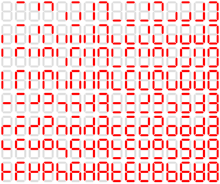128 (number)
Appearance
(Redirected from 1B7)
| ||||
|---|---|---|---|---|
| Cardinal | one hundred twenty-eight | |||
| Ordinal | 128th (one hundred twenty-eighth) | |||
| Factorization | 27 | |||
| Divisors | 1, 2, 4, 8, 16, 32, 64, 128 | |||
| Greek numeral | ΡΚΗ´ | |||
| Roman numeral | CXXVIII, cxxviii | |||
| Binary | 100000002 | |||
| Ternary | 112023 | |||
| Senary | 3326 | |||
| Octal | 2008 | |||
| Duodecimal | A812 | |||
| Hexadecimal | 8016 | |||
128 (one hundred [and] twenty-eight) is the natural number following 127 and preceding 129.
In mathematics
[edit]128 is the seventh power of 2. It is the largest number which cannot be expressed as the sum of any number of distinct squares.[1][2] However, it is divisible by the total number of its divisors, making it a refactorable number.[3]
The sum of Euler's totient function φ(x) over the first twenty integers is 128.[4]
128 can be expressed by a combination of its digits with mathematical operators, thus 128 = 28 − 1, making it a Friedman number in base 10.[5]
128 is the only 3-digit number that is a 7th power (27).
In bar codes
[edit]- Code 128 is a Uniform Symbology Specification (USS Code 128) alphanumeric bar code that encodes text, numbers, numerous functions, and designed to encode all 128 ASCII characters (ASCII 0 to ASCII 127), as used in the shipping industry.
- Subdivisions include:
- 128A (0–9, A–Z, ASCII control codes, special characters)
- 128B (0–9, A–Z, a–z, special characters)
- 128C (00–99 numeric characters)
- GS1-128 application standard of the GS1 implementation using the Code 128 barcode specification
- ISBT 128 system for blood product labeling for the International Society of Blood Transfusion
In computing
[edit]- 128-bit key size encryption for secure communications over the Internet

- Seven-segment displays have 128 possible states.
- ASCII includes definitions for 128 characters (33 non-printing characters, mostly obsolete control characters that affect how text is processed, and 94 printable)
- A 128-bit integer can represent up to 3.40282366...e+38 values (2128 = 340,282,366,920,938,463,463,374,607,431,768,211,456).
- CAST-128 is a block cipher used in a number of products, notably as the default cipher in some versions of GPG and PGP.
- Graphics cards have a 128-bit, 256-bit, or 512-bit data bus to memory.
- Atari 2600 consoles have 128 bytes of memory
- Sony's PlayStation 2 Emotion Engine CPU has two 128-bit vector units
- Macintosh 128K, the original Apple Macintosh personal computer released in 1984
- Laser 128, an Apple II clone released in 1984
- Commodore 128, a home/personal computer which had a 128 KB of memory released in 1985
- Enterprise 128 Zilog Z80, a home computer released in 1985
- Jane 128, a GUI-based integrated software package for the Commodore 128 personal computer released in 1985
- RIVA 128 (Real-time Interactive Video and Animation accelerator), one of the first consumer graphics chips to integrate 3D and video acceleration in 1997
- Super Mario 128, a cancelled Nintendo game, though many elements were included in Super Mario Galaxy and Pikmin
In the military
[edit]- USNS Mission San Luis Rey (T-AO-128), a United States Navy Mission Buenaventura-class fleet oilers during World War II
- USS Arenac (APA-128), a United States Navy Haskell-class attack transport during World War II
- USS Cavallaro (APD-128), a United States Navy Crosley-class high speed transport
- USS Leonis (AK-128), a United States Navy Crater-class cargo ship during World War II
- USS Velocity (AM-128), a United States Navy Auk-class minesweeper which removed naval mines laid in the water
In transportation
[edit]- Fiat 128, a small car manufactured by Fiat from 1969 to 1985.
- SEAT 128, a 2-door coupe version of the Fiat 128
- The BMW 128i convertible
- 128 is the number of many roads, including Massachusetts Route 128, Boston's inner beltway.
- Route 128 Station is a stop on the Massachusetts Bay Transportation Authority Attleboro/Providence MBTA Commuter Rail line in Westwood, Massachusetts
- STS-128 was a Space Shuttle Discovery mission to the International Space Station in 2009
In other fields
[edit]One hundred [and] twenty-eight is also:
- The year AD 128 or 128 BC
- 128 AH, a year in the Islamic calendar that corresponds to 745 – 746 CE
- 128 Nemesis, a main-belt asteroid
- Ross 128, a red dwarf star, the eleventh closest star system to the Solar System
- 128P/Shoemaker-Holt, a periodic comet in the Solar system
- The atomic number of unbioctium, an element yet to be discovered
- The number of musical instruments specified in General MIDI. Sometimes they are numbered 0 to 127 and sometimes they are numbered 1 to 128
- 128 film, a film format
- Sonnet 128 by William Shakespeare
- In music, a hundred twenty-eighth note is a note played for 1/128 of the duration of a whole note
- The number of US fluid ounces in a US gallon
See also
[edit]Notes
[edit]- ^ Sprague, R. (1948), "Über Zerlegungen in ungleiche Quadratzahlen", Math. Z., 51 (3): 289–290, doi:10.1007/BF01181594, MR 0027285, S2CID 123515191
- ^ OEIS:A001422. Similarly, the largest numbers that cannot be expressed as sums of distinct cubes and fourth powers, respectively, are 12758 and 5134240 (sequence A001661 in the OEIS).
- ^ OEIS:A033950.
- ^ OEIS:A002088.
- ^ OEIS:A036057.
References
[edit]- Wells, D. The Penguin Dictionary of Curious and Interesting Numbers London: Penguin Group. (1987): 138
External links
[edit]Wikimedia Commons has media related to 128 (number).
